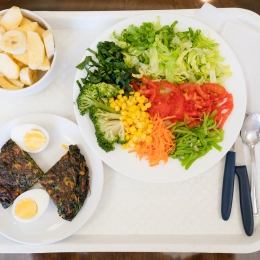Government food purchasing and service: Compare and contrast standards
A healthy and values-aligned public food purchasing and service policy at the federal, state, or local level should include standards that food purchasing agencies and contractors must meet or work toward over time. Several organizations have created such standards. This resource describes five sets of standards developed by non-profit and government bodies to help advocates and policymakers understand how each set of standards would align with their policy goals.
About the models
Food Service Guidelines for Federal Facilities (FSG)
The FSG were developed by a working group of nine federal agencies led by the Centers for Disease Control and Prevention. Their purpose is to provide voluntary standards for food, nutrition, facility efficiency, environmental support, community development, food safety, and behavioral design for use in food service concession and vending operations in federal facilities. The FSG may also serve as a model for food service operations at state, local, and tribal government facilities.
Good Food Purchasing Program (GFPP)
The GFPP provides a metric-based, flexible framework that encourages large institutions to direct their buying power toward five core values, in alignment with the Anchors in Action Aligned Framework (Box). When an institution adopts the GFPP, the Center for Good Food Purchasing works with them to establish supply chain transparency from farm to fork, evaluate how current purchasing practices align with the Good Food Purchasing Standards, assist with goal setting, measure progress, and celebrate institutional successes. Enrolled institutions include school districts, jails, hospitals, and other local government agencies and meal programs.
Health Care Without Harm (HCWH)
HCWH works to transform health care worldwide to reduce its environmental footprint, become a community anchor for sustainability, and a leader in the global movement for environmental health and justice. Its food purchasing guidance, based on the AiA Aligned Framework, is intended to help hospitals purchase food that aligns with their values. The strategies are broken down into three categories: sustainable purchasing, local purchasing, and purchasing that supports social equity.
Real Food Challenge (RFC)
RFC is a program of Uprooted and Rising that leverages the higher education sector’s institutional resources for community-controlled food systems. The Real Food Standards is a tool that provides strategies for campuses to advance five values in our food system, in alignment with the AiA Aligned Framework.
National Alliance for Nutrition and Activity (NANA)
CSPI facilitates NANA, a coalition advocating for national policies to make it easier to eat healthfully and be physically active. NANA adapted these guidelines from the U.S. Department of Agriculture’s Smart Snacks guidelines of schools. They are intended to improve access to healthy food and beverage options in vending machines, checkout aisles, and other “grab-and-go” venues. Last updated in 2020, the guidelines include model standards for single-serve beverages, snacks, and entrees.
A unified framework
Anchors in Action (AiA) Aligned Framework
The AiA Aligned Framework, which provides shared definitions, certifications and attributes, measures, and strategies to operationalize five core values in institutional food purchasing: local and community based economies, environmental sustainability, valued workforce, animal welfare, and community health and nutrition.
The latest
DC Council bill falls short of needed improvements to jail food
Government Accountability

How the Biden administration can transform food in federal facilities for millions of people
Government Accountability

Biden administration makes progress toward hunger and nutrition commitments but major items still outstanding
Government Accountability

Incarcerated people deserve healthy meals and a balanced diet
Government Accountability

Biden Administration urged to improve federal food service guidelines
Food Service

Tags
Topics

